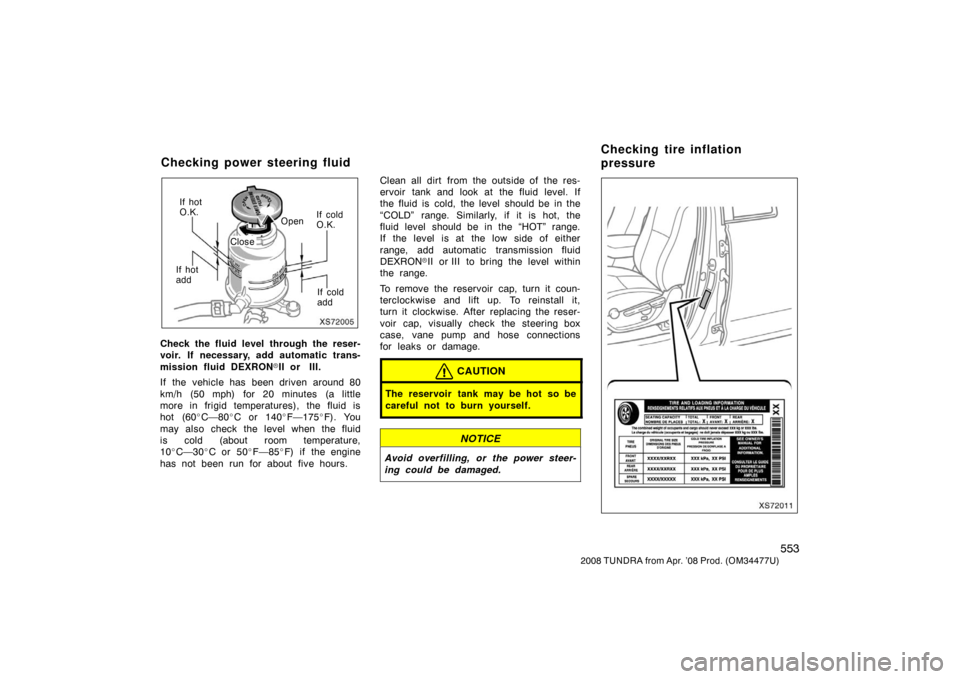Page 562 of 621

552
2008 TUNDRA from Apr. ’08 Prod. (OM 34477U)
If either of the above parts are extremely
dirty or you are not sure of their condi-
tion, take your vehicle to a Toyota dealer.
CAUTION
To prevent burning yourself, be care-
ful not to touch the radiator or con-
denser when the engine is hot.
NOTICE
To prevent damage to the radiator
and condenser, do not perform the
work by yourself.
Checking brake fluid
XS72003
To check the fluid level, simply look at
the see�through reservoir. The level
should be between the “MAX” and
“MIN” lines on the reservoir.
It is normal for the brake fluid level to go
down slightly as the brake pads wear. So
be sure to keep the reservoir filled.
If the reservoir needs frequent refi lling, it
may indicate a serious mechanical prob-
lem.
If the level is low, add SAE J1703 or
FMVSS No.116 DOT 3 brake fluid to the
brake reservoir. Remove and replace the reservoir cap by
hand. Fill the brake fluid to the dotted
line. This brings the fluid to the correct
level when you put the cap back on.
Use only newly opened brake fluid. Once
opened, brake fluid absorbs moisture from
the air, and excess moisture can cause a
dangerous loss of braking.
CAUTION
Take care when filling the r
eservoir
because brake fluid can harm your
hands or eyes. If fluid gets on your
hands or in your eyes, flush the af-
fected area with clean water immedi-
ately. If you still feel uncomfortable
with your hands or eyes, go to the
doctor.
NOTICE
If you spill some of the fluid, be sure
to wipe it off to prevent it from dam-
aging the parts or paintwork.
Checking the radiator and
condenser
Page 563 of 621

553
2008 TUNDRA from Apr. ’08 Prod. (OM 34477U)
XS72005
If hot
O.K.
OpenIf cold
O.K.
If hot
add If cold
add
Close
Check the fluid level through the reser-
voir. If necessary, add automatic trans-
mission fluid DEXRON�II or III.
If the vehicle has been driven around 80
km/h (50 mph) for 20 minutes (a little
more in frigid temperatures), the fluid is
hot (60 �C—80 �C or 140 �F—175 �F). You
may also check the level when the fluid
is cold (about room temperature,
10 �C—30 �C or 50 �F—85 �F) if the engine
has not been run for about five hours. Clean all dirt from the outside of the res-
ervoir tank and look at the fluid level. If
the fluid is cold, the level should be in the
“COLD” range. Similarly, if it is hot, the
fluid level should be in the “HOT” range.
If the level is at the low side of either
range, add automatic transmission fluid
DEXRON
�II or III to bring the level within
the range.
To remove the reservoir cap, turn it coun-
terclockwise and lift up. To reinstall it,
turn it clockwise. After replacing the reser-
voir cap, visually check the steering box
case, vane pump and hose connections
for leaks or damage.
CAUTION
The reservoir tank may be hot so be
careful not to burn yourself.
NOTICE
Avoid overfilling, or the power steer-
ing could be damaged.
XS72011
Checking power steering fluid Checking tire inflation
pressure
Page 575 of 621

565
2008 TUNDRA from Apr. ’08 Prod. (OM 34477U)
NOTICE
�Be sure the engine and all accesso-
ries are off before performing main-
tenance.
� When checking the battery, remove
the ground cable from the negative
terminal (“�” mark) first and rein-
stall it last.
� Be careful not to cause a short cir-
cuit with tools.
� Take care no solution gets into the
battery when washing it.
If the battery is disconnected or run
down, the moon roof may not operate
automatically and the jam protection func-
tion will not function correctly after you
reconnect, replace or recharge the battery.
In any of these cases, you should normal-
ize the moon roof. To normalize the moon
roof, see “Electric moon roof” on page 43
in Section 1 −2.
Ty p e A
Green Dark Clear or
light yellow
Ty p e B Blue White Red
CHECKING BY INDICATOR
Check the battery condition by the indi-
cator color.
Indicator color
ConditionTy p e ATy p e B
GreenBlueGood
DarkWhite
Charging necessary.
Have battery checked
by your Toyota
dealer.
Clear orlight
yellow
Red
Have battery checked
by your Toyota
dealer.
During recharging, the battery produces
hydrogen gas.
Therefore, before recharging:
1. If recharging with the battery installed on the vehicle, be sure to disconnect
the ground cable.
2. Be sure the power switch on the re- charger is off when connecting the
charger cables to the battery and when
disconnecting them.
CAUTION
�Always charge the battery in an un-
confined area. Do not charge the
battery in a garage or closed room
where there is not sufficient ventila-
tion.
�Only do a slow charge (5 A or
less). Charging at a quicker rate is
dangerous. The battery may ex-
plode, causing personal injuries.
NOTICE
Never recharge the battery while the
engine is running. Also, be sure all
accessories are turned off.
—Checking battery fluid Battery recharging precautions
Page 576 of 621
566
2008 TUNDRA from Apr. ’08 Prod. (OM 34477U)
LS73002
Good
Blown
Ty p e A
XS73029
Good Blown
Ty p e B
GN73013
Good Blown
Ty p e C
XS73002
If the headlights or other electrical
components do not work, check the
fuses. If any of the fuses are blown,
they must be replaced.
See “Fuse locations” on page 543 in Sec-
tion 7
−1 for locations of the fuses.
Turn the engine switch and inoperative
component off. Pull the suspected fuse
straight out and check it.
Determine which fuse may be causing the
problem. The lid of the fuse box shows
the name of the circuit for each fuse. See
page 595 in Section 8 for the functions
controlled by each circuit.
Checking and replacing fuses
Page 601 of 621

591
2008 TUNDRA from Apr. ’08 Prod. (OM 34477U)
COOLING SYSTEM
Total capacity, L (qt., Imp. qt.):
4.0 L V6 (1GR −FE) engine
9.6 (10.1, 8.4)
4.7 L V8 (2UZ −FE) engine
9.7 (10.3, 8.5)
5.7 L V8 (3UR −FE) engine
With towing package
13.0 (13.7, 11.4)
Without towing package 12.1 (12.8, 10.6)
Coolant type: “Toyota Super Long Life Coolant” is
used in your Toyota vehicle at factory
fill. In order to avoid technical problems,
only use “Toyota Super Long Life
Coolant” or similar high quality ethylene
glycol based non −silicate, non −amine,
non− nitrite, and non− borate coolant with
long− life hybrid organic acid technology.
(Coolant with long −life hybrid organic
acid technology is a combination of low
phosphates and organic acids.)
Do not use plain water alone.
Please contact your Toyota dealer for
further details. BATTERY
Open voltage
∗ at 20
°C (68 °F):
12.6—12.8 V Fully charged
12.2—12.4 V Half charged
11.8—12.0 V Discharged
∗: Voltage that is checked 20 minutes after the key is removed with all the
lights turned off
Charging rates: 5 A max. AUTOMATIC TRANSMISSION
Fluid capacity, L (qt., Imp. qt.):
4.0 L V6 (1GR −FE) engine
10.5 (11.1, 9.2)
∗
4.7 L V8 (2UZ −FE) engine
With towing package 11.1 (11.7, 9.8)
∗
Without towing package10.5 (11.1, 9.2)∗
5.7 L V8 (3UR−FE) engine
With towing package 11.7 (12.4, 10.3)
∗
Without towing package 11.1 (11.7, 9.8)∗
∗
: The fluid capacity is the quantity of ref- erence. If replacement is necessary,
contact your Toyota dealer.
Fluid type: Toyota Genuine ATF WS
Change automatic transmission fluid only
as necessary.